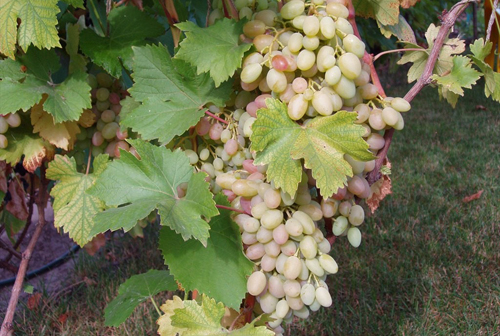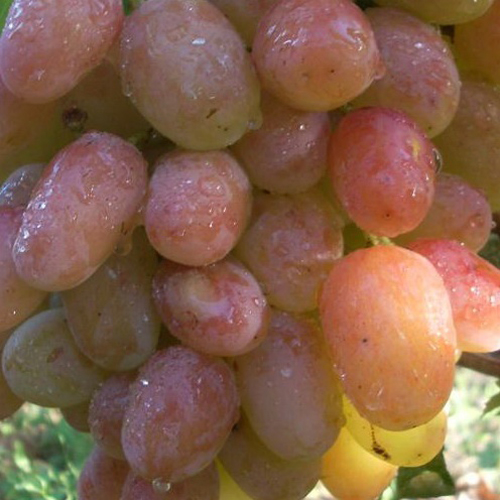Vodogray grape variety
Vodogray is a wonderful fruit of the labors of the national breeder Vitaly Zagorulko from the Zaporozhye region of Ukraine. It was obtained as a result of crossing two famous varieties - Arcadia and Radiant kishmish... By the way, this is one of the few cases when in amateur breeding a bisexual variety of grapes was used as a mother form, which indicates the growing skill of the researcher, who is able to work not only with the functionally female type of flower.

In addition to its excellent aesthetic and gastronomic qualities, the variety is distinguished by its high vigor and increased productivity. Of the negative characteristics, a very modest resistance to fungal diseases and low frost resistance of plants can be noted. Despite this, the hybrid form enjoys significant popularity both at home and abroad. The army of her sincere admirers today can be assessed as very impressive in size. Moreover, the territory occupied by this army is very vast and is not limited to traditional wine-growing regions.
Agrobiological characteristics of the variety
Grape bushes, especially on their own roots, grow very vigorous with a long annual growth. The crown of a young shoot is light green, shiny, without signs of pubescence. The leaves of Vodograi are medium and large in size, stretched in width, five-lobed with an average degree of dissection. The front side of the leaf is reticulate-wrinkled, usually not too saturated green. The upper side notches are deep enough, can be of two types: closed with an ovoid lumen and open lyre with a rounded bottom. The lower notches are an order of magnitude smaller, for the most part slit-like. The petiole is open lyre-shaped with a flat or slightly pointed bottom. Petioles are long, pale green with a slight pink tint at the base. The veins of the leaves are colored in the same way. The denticles along the edges of the leaf blade are of various sizes, triangular with a wide base, slightly convex sides and a sharp apex. The flowers are bisexual, due to which there are no problems with pollination, the bunches are not threatened with excessive friability, and the berries are pea only occasionally. During the growing season, the shoots have time to mature perfectly, while changing the color from reddish green to light brown.
Bunches of grapes are quite massive, with an average weight of 500-700 grams, individual ones - up to one and a half kilograms, cylindrical, or conical, moderately loosened. The combs are long, strong enough, green in color. Vodograi berries are large, oval or nipple-shaped, 28-34 mm long, 18-20 mm in diameter in the wide part, pleasant pink color with a slight bloom of prune on the surface. The uniformity of the grapes within the cluster is average. The mass of one berry ranges from 8-12 grams. The pulp is sweet, juicy-fleshy, has a harmonious taste, and that is especially appreciated by many winegrowers - the aroma of nutmeg. The juice is uncolored, the sugar content is high for table varieties - 18-20 g / 100 ml, the titratable acidity is 6-7 g / l. The skin is firm, but not too thick, chewable without problems when eating. The seeds are found, up to three in number in the berry, however, they do not carry significant negative assessments, and therefore the tasting characteristics of the grapes always remain at their best. In some unfavorable seasons, especially when the bushes are overloaded with crops, there may be an inexpressive taste of the berries and a liquefaction of their consistency. In this case, gastronomic assessments naturally decrease.

The lion's share of the harvested crop is used for fresh consumption. Elegant, fragrant and very sweet bunches leave no one indifferent to those who taste them.The variety looks great on the market counters, and due to its high presentation it is in high demand among buyers. For this reason, Vodogray can take a well-deserved place on farm plantations, the owners of which can be absolutely sure that the harvest will not remain unclaimed. Winogadari-lovers also cannot praise them, rightly noting that the form, in terms of the combination of gastronomic and aesthetic qualities, is one of the most noticeable on their backyard plots. But the variety does not shine with high indicators of transportability of bunches, due to the relatively easy separation of berries from the crest, which, when transported over long distances, can lead to significant losses and deterioration of the marketable type of grapes. It is stored somewhat better due to the strong skin of the berries, but for this it also requires the creation of an optimal microclimate in the storage room.
The variety belongs to the group with an early-medium ripening period. The growing season, calculated from the moment the buds bloom in the spring, until the berries set the conditions corresponding to the onset of removable ripeness, is 120-125 days. Her need for heat during this time, expressed in the sum of active temperatures, is 2550-2650 ° C. In the traditional wine-growing regions of our country, harvesting begins closer to mid-August, but the geography of its distribution is not limited only to the south. Amateurs grow the variety throughout the Central Black Earth Region of the Russian Federation, the lower Volga region, in many regions of Ukraine and even in the south of Belarus. At the same time, the frost resistance of the bushes is at an average level (-21 ° C), which determines the need for mandatory shelter of the vine for the winter in most regions of grape growing.
Vodograi demonstrates significant productivity indicators and the ability to “pull out” rather large crop loads. For outstanding productivity, it has all the makings - high vital energy, a large bunch, a large percentage of fruitful shoots and a very good fruiting factor, reaching 1.7. However, this does not mean that the generosity of the hybrid can be used uncontrollably, exhausting the plants with annual overloads, and thereby increasing the risk of death of weakened bushes in winter. And even without such fatal consequences, congestion contributes to the lengthening of the ripening period of the bunches, significantly reduces the size of the fruits, worsens the texture and taste of berries, and reduces sugar accumulation. To prevent this, it is required to carry out a thorough rationing of the yield of the variety every year in strict accordance with the age, strength of growth, the level of agricultural technology and care for each specific plant.

Bunches and grapes that have reached removable ripeness can remain on the bushes for a long time, gradually becoming even sweeter and enhancing their nutmeg aroma. The conditions for this are warm, dry weather, moderate soil moisture, and no risk of early autumn frosts. The variety is not very prone to cracking of grapes, however, in the event of the onset of cold damp weather, especially replacing the summer drought, the "crackle" of berries can still appear. There is little evidence of a strong crop defeat by wasps, and they contradict the statements of other winegrowers who claim that annoying insects bypass our hero. Therefore, protection against them should be applied selectively, depending on the urgency of the problem in a particular area.
Agrotechnical features
The economic characteristics of Vodogray in many ways look good, but some of them do not allow us to call it a highly resistant and extremely unpretentious grape. Therefore, in order to obtain high yields of good quality, the winegrower will have to take into account the specifics of the variety and competently level out his shortcomings in agrobiology.
The planting of the vineyard should be carried out according to the principles generally accepted for culture. The hybrid does not show any peculiarities in this respect.The most heated places in the upper part of the slopes of warm exposures are selected for planting, and if we are talking about summer cottages, gardening and backyard plots, then in case of a risk of insufficient SAT level, the bushes are placed under the protection of various buildings on their southern side. Cold slopes, gullies and valleys are unacceptable for grapes. The moisture content of the soil is desirable sufficient, both a lack and an excess of moisture will not allow the plants to develop normally. Soil fertility can be different, but at a low level, you should take special care of the availability of mineral nutrition for young bushes in the early years of their development, through regular feeding.
The phylloxera resistance of Vodogray is not known for certain, and therefore, in order to avoid unnecessary disappointments, it is planted in regions infected with phylloxera with grafted seedlings, in which special resistant varieties are used as rootstocks. This method of reproduction, although it is more complicated than rooted, but, nevertheless, guarantees normal development and long life even for varieties of grapes that are highly susceptible to root aphid. Our hero can take root on his own, however, planting him in this form is possible only in territories that are guaranteed free from phylloxera.
Almost everywhere, with the exception of the mild subtropical climate on the Black Sea coast, the cultivation of this hybrid form is possible only in a covering culture, for which the Vodograi bushes from the first years of life are formed according to special squat patterns like Guyot, a multi-arm fan or an oblique cordon. They allow you to remove and return the vine to the trellis without much damage. The shelter is made both with earth from the rows, and with improvised insulation materials - straw, peat, spruce branches, reeds, etc. Tunnel film shelters are also often used. The choice of method depends primarily on the frost hazard of a particular region.
The regulation of the load on the variety is one of the main activities in a vineyard that has begun to bear fruit. In this case, for optimal results, spring pruning of fruit arrows is carried out on 4-8 buds, with a total load on the bush within 30-35 eyes. After the beginning of the development of grape shoots, they break off the sterile and weak, so that 20-24 fruitful vines remain on the plant. The inflorescences on them are also thinned out, observing the rule of 1 shoot - 1 bunch, making exceptions only for the most powerful of them, on which you can leave two brushes.
In terms of resistance to diseases, Vodogray is at an intermediate level between susceptibility and tolerance, which, of course, is better than the classic "noble" varieties, but still not enough to refuse multiple chemical treatments. To maintain a good phytosanitary condition of grape bushes, it will take up to 4-6 spraying with fungicides per season, depending on the weather conditions of a particular year.








